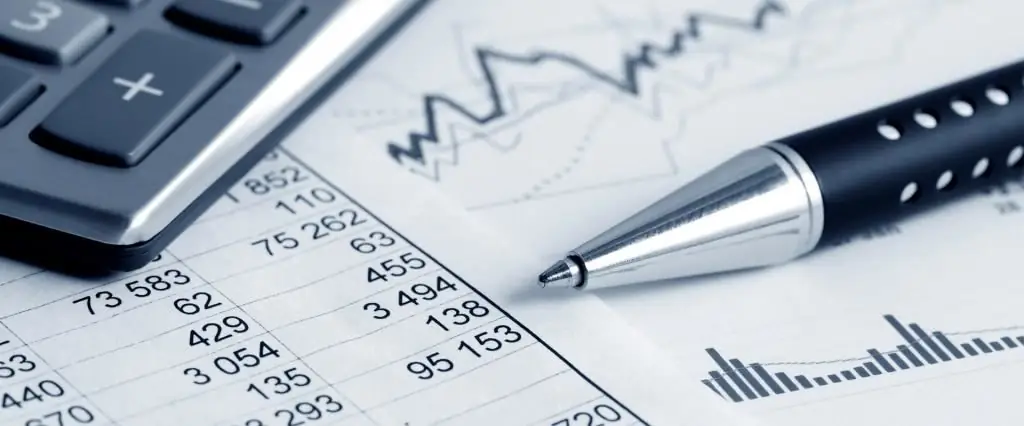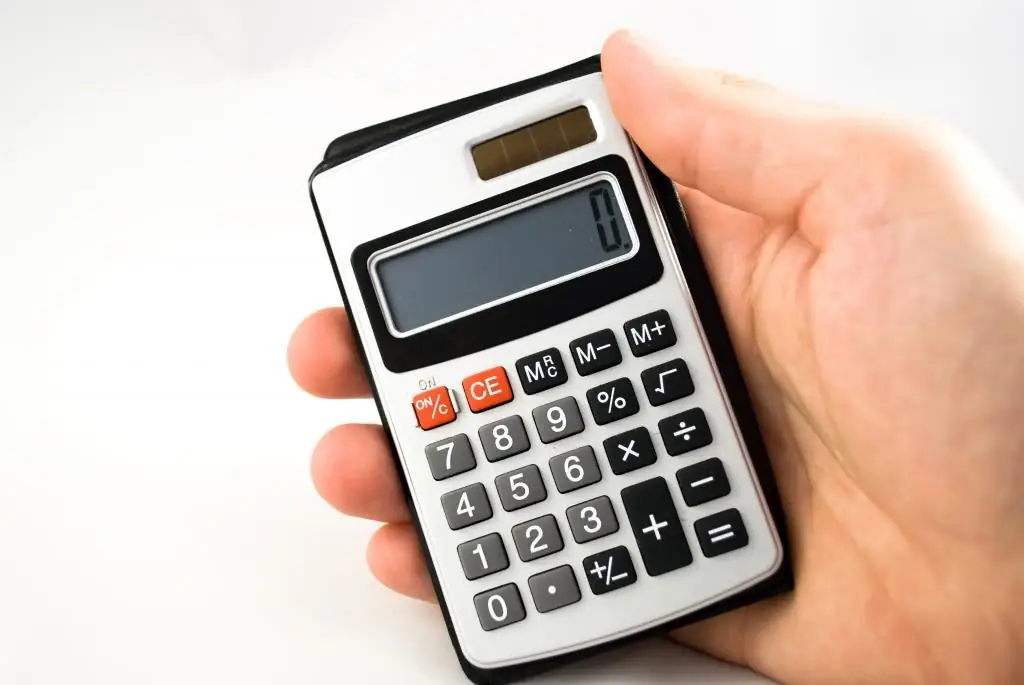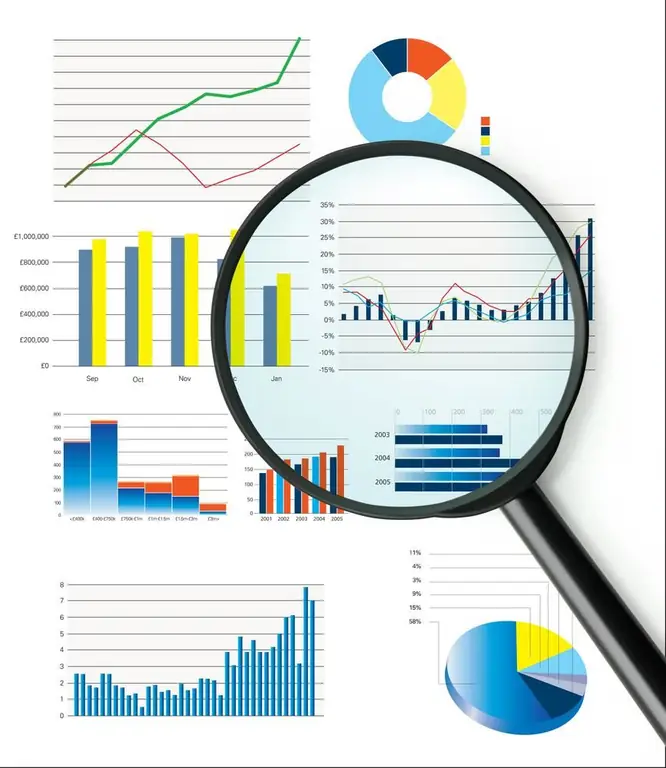2025 Author: Howard Calhoun | [email protected]. Last modified: 2025-01-24 13:10:33
To reveal the essence of any science, you need to understand that there are three components of the study of any discipline: subject, object and method. The subject will tell us about what science is studying, and with the help of the method we will understand how it does it, but the object is a combination of different features being studied.
For a deeper understanding of the topic, let's analyze in detail what accounting is, what tasks and goals this science sets for itself.
Term Definition
Accounting is a unified system for collecting, registering and summarizing information in monetary terms about the existing property, obligations of the organization and cash flows, by the method of continuous, documentary and continuous accounting of all economic interactions.
The Accounting Law states that the following people can keep accounting records:
- chief accountant, who is registered in a labor organizationcontract;
- staff accountant, also registered in an organization under an employment contract;
- general director (in the absence of an accountant);
- a firm that provides accounting support for an organization.

About the subject, object and accounting method
As mentioned earlier, the definition of an accounting method implies how and with the help of what methods a scientific discipline studies a subject.
The method is based on general methods of cognition of the world, but there are also individual methods of studying this science. Accounting reflects the property and monetary assets of the organization, as well as the sources of their formation. These sources are called liabilities because they are always opposed to assets.
To achieve a balance of assets and liabilities, use the balance method. This method aims to measure these quantities and obtain up-to-date information.
In accounting, each operation affects the property and monetary assets of the organization, so it is so important to form visual figures about the organization's activities. That's what accounting methods are for. This is a set of techniques and tools that reflects the financial and economic interactions of an economic unit, and also involves special methods of generalization, grouping and calculations. The subject and method of accounting are interconnected.
The subject of accounting (in the general sense) is all of its financial and economic activities, whichimplemented through various operations and actions.
The subject and object of accounting are very interconnected, the object represents various types of property of the organization for its activities, financial and business transactions, due to which it is possible to change the composition of the property.
Types of accounting
The following types of accounting can be distinguished:
- Administrative - information is collected, processed and provided for the needs of the actual management of the organization. The main points are cost accounting and cost analysis.
- Management accounting is related to the analytics of information for the executives of an organization.
- Financial accounting - information about the income and expenses of the organization, about receivables and payables.
- Tax accounting is a generalization and analysis of information in order to determine the tax base according to primary documentation.
Accounting functions
In addition to species, the main functions can be distinguished:

- Controlling - control over the availability and safety of property items and funds.
- Information - the most important function, its importance is that it is the primary source of information for all departments of the organization and its leaders.
- Feedback - accounting communicates information.
- Analytical - analysis of all organizational structures, profit and loss to optimize performance.
Basic Accounting Methods
Above we figured out what ismethod, but in order to understand what methods modern accounting offers us, let's dwell on a detailed list of each of them.
So, accounting methods:
- Documentation
- Invoices
- Double entry
- Inventory
- Rating
- Calculation
- Balance
- Reports
Documentation

Using a specific example, you can analyze in detail the smallest elements of accounting methods.
Accounting cannot be carried out without documents that are a written confirmation of the act of any business transaction. Documents in the organization go from their creation to being sent to the archive and are carefully stored so that if missing economic property is found, it will be possible to track its movement in the enterprise.
In any organization, various financial and business transactions are performed daily, each of which must be documented in a document that contains all the information about rights and obligations. Only correctly executed paper guarantees legal rights for operations.
Let's consider the concepts related to the characteristics of this accounting method:
| Documentation | Not a single financial and economic transaction can be recorded without timely execution of documents. This is the primary stage of accounting. |
| Unification of documents | The process of creating different forms of documents for the design of homogeneousfinancial transactions. Unified documents are approved by the State Statistics Committee of the Russian Federation. |
| Standardization | Creation of standard forms of general type documents. Standardization makes accounting documentation much easier. |
| Document flow | This is the movement of a document from its compilation to storage in the archive. The development of document flow in the organization is carried out by the chief accountant. It is the absence of this characteristic that leads to chaos in the documents. |
Invoices
One of the accounting methods is an account, which is a means of grouping and controlling changes to some objects. This is a special table with two sides, on the left - debit, on the right - credit.
Based on content, accounting accounts are divided into:
- active - property is considered by composition and placement;
- passive - accounting for property by its formation.
| Active account | Passive account | ||
| Debit | Credit | Debit | Credit |
| Opening balance | Opening balance | ||
| Increase | Decrease | Decrease | Increase |
| Final balance | Final balance | ||
Balance is the difference between expenses and receipts. On an active account - it is either in debit or absent. On a passive account - a balance either in credit,or missing.
There is also a combined method, which includes the characteristics of both accounts and is maintained for a specific calculation.
| Active-passive account | |
| Debit | Credit |
| Opening balance | Opening balance |
|
Increase Decrease |
Decrease Increase |
| Turnover | Turnover |
| Closing balance | Closing balance |
In addition to balance sheet accounts, there is an off-balance group: it calculates the values of the organization that are not directly owned, but leased or stored.
Double entry
Another accounting method is double entry. It is a display of data in which each business transaction is displayed twice in the accounts: on the debit of one and the credit of the other, which are interconnected.
Elements of accounting method:
- Correspondence - the relationship of two accounts, which is born with a double entry.
- Posting - a type of registration of account correspondence, when a single entry is made on the debit and credit of accounts. Simple posting - linking two accounts, complex posting - linking more than two accounts.
Inventory

An example of an accounting method is inventory. For order in accounting documents, relevance and reliabilityentered and entered data, the organization is engaged in an inventory of property, which must be confirmed in writing - acts and invoices. In this process, the presence and state of objects are confirmed. Inventory should be carried out regularly and is one of the main accounting methods to ensure the financial stability of the enterprise.
The frequency of this event and the list of checked items is approved by the manager, but there are cases when the inventory is carried out forcibly:
- if the property of the organization is leased, it is redeemed or put up for sale;
- restructuring or rebranding of an organization;
- if there is an annual accounting report;
- if the fact of theft or damage to a financial and economic object is detected in the organization;
- in case of emergencies (fire, flood);
- if the organization goes into liquidation or goes bankrupt.
Rating
Evaluation in accounting is usually called the expression of the value of an object in monetary terms. In simple words, the characteristic of the accounting method through evaluation is understood as the monetary value of the object, which is recorded in the documents.
Evaluation of objects is compiled according to two principles:
- The reality of the assessment is the actual value of the funds and their sources, in other words, the amount of money must correspond to the value of the object in fact. This principle requires an accurate calculation of accounting objects.
- Unity of evaluation -the same object of economic relations must be equally valued in any organization during the period of its presence at the turnover stage. Unity is achieved through mandatory cost documentation and costing.
Methods of evaluation:
- Fixed assets - the assessment is displayed in the financial statements at initial or residual value.
- Intangible assets - valuation at original or residual value.
- Materials - valued at actual purchase cost or planned cost.
- Finished Goods - valuation taking into account all costs for the production of the product or at those prices that were set at a certain point in time.
- Accounts payable - valuation according to the amounts that were determined in the contract (purchase and sale, employment contract, etc.)
- Authorized capital - is estimated at the amount indicated in the documents of the organization, even if the authorized capital is not fully paid.
- Cash - reflected in the analytics of the financial report in national or foreign currency.
Calculation

This accounting method calculates the value of accounting items and how they are valued in monetary terms.
The subject of the calculation is an object, the cost of which is needed for various needs of the organization.
All activities of the enterprise, all its financial and economic objects and relations are subject to mandatory calculation. If an organization acquires anyor means of production, it is necessary to calculate their cost, then in the manufacturing process, the cost of the entire process is revealed. At the final stage of sales, the total cost of production is calculated and the profit is calculated.
Thus, costing is one of the most important accrual methods in accounting, a necessary complement to valuation.
Balance sheet

The balance sheet is the summing up of the closing balances of all existing accounts.
This accounting method is presented in the form of the following table:
| Asset | Passive |
|
Fixed assets Materials Cashier Initial total |
Authorized fund Profit Bank loan Initial total |
| Final result | Final result |
The balance total is the currency. There are 5 types of them:
- Reporting - the amount for the reporting date.
- Introductory - accounts of the organization at the initial stage of activity.
- Liquidation - the balance that is available at the time of liquidation of the organization.
- Dividing - make up at the time of the division of the organization.
- Unifying - when two or more organizations merge.
Reporting

This is a set of all indicators that reflect the financial position of the organization. Also, these are property and financial results for the requiredperiod of time.
Accounting statements are comprehensive information about the activities of all branches and divisions of an organization.
Reporting contains:
- balance sheet (form 1);
- accountant's report on the organization's profit and loss (form 2);
- addition to the balance sheet according to the report;
- Auditor's report.
Reporting is prepared by an accountant for one month, one quarter and one year. Monthly and quarterly reporting - subtotals.
The reporting year of the organization is from January 1 to December 31. For only created - from the date of registration to December 31.
Recommended:
Accounting documents are The concept, rules for registration and storage of accounting documents. 402-FZ "On Accounting". Article 9. Primary accounting documents

Proper execution of accounting documentation is very important for the process of generating accounting information and determining tax liabilities. Therefore, it is necessary to treat documents with special care. Specialists of accounting services, representatives of small businesses who keep independent records should know the main requirements for the creation, design, movement, storage of papers
What is labor rationing? Basic concepts, organization, types, methods of calculation and accounting

Thinking about what labor rationing is, many of us have associations of production, an uninterrupted workflow. This term is of great importance in economic planning. And although today you can often hear the opinion that the rationing of the work of workers is an echo of the Soviet system of production, most industrial enterprises are in no hurry to abandon the use of this tool
Methods of making managerial decisions and their characteristics

Management decision is the choice of one of the possible alternatives. The choice is made on the basis of an analysis of the causes of the situation to be resolved. Making managerial decisions and taking responsibility for them is the most important function of management. The methods of developing and making managerial decisions are diverse and not similar to each other. The task of the manager is to choose the appropriate method and apply it correctly
Accounting for working hours in the summary accounting. Summarized accounting of the working time of drivers with a shift schedule. Overtime hours with summarized accounting of wor

The Labor Code provides for work with a summarized accounting of working hours. In practice, not all enterprises use this assumption. As a rule, this is due to certain difficulties in the calculation
Basic tillage: techniques and methods of processing, characteristics

The main tillage is called its deep loosening in order to increase air and moisture permeability. Plowing the land can be done in different ways. Most often, this procedure is performed with a reservoir turnover

